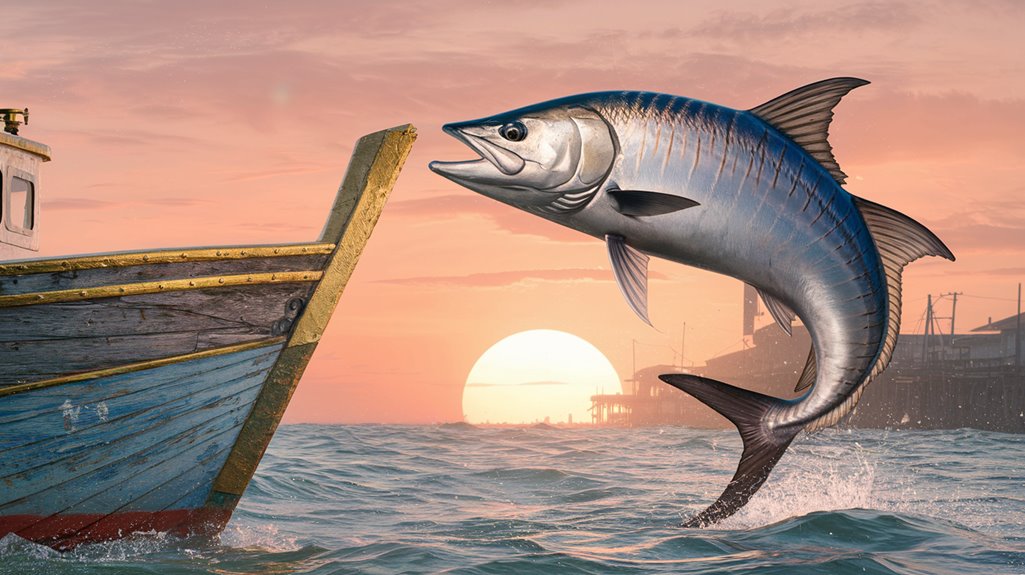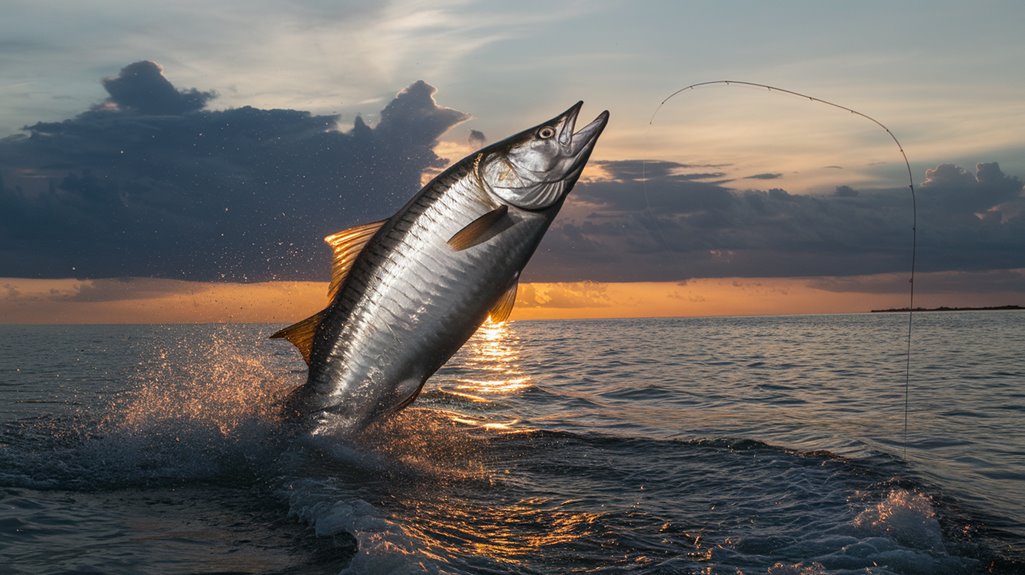Like ancient gladiators of the sea, tarpon command respect in Galveston Bay's fertile waters. You'll find these silver-scaled giants patrolling the deep channels and jetties, often reaching weights over 200 pounds. When you're hooked up with a tarpon, you're not just fishing – you're engaging in an age-old battle of wit and strength. Their explosive jumps and searing runs have earned them a legendary status, and there's much more to mastering these magnificent gamefish than meets the eye.
Key Takeaways
- Tarpon in Galveston Bay can exceed 200 pounds and showcase spectacular aerial displays during intense battles with anglers.
- Prime fishing occurs between July and November in "tarpon alley," stretching from High Island to San Luis Pass.
- Heavy-duty gear including 50-pound braid, 80-pound leader, and large circle hooks are essential for landing these powerful fish.
- Successful fights require maintaining high rod position during runs and dropping it during jumps, with battles lasting 20-30 minutes.
- Live bait, particularly 8-inch mullet, combined with quick multiple hook sets helps penetrate the tarpon's bony jaw structure.
The Silver Kings of Galveston Bay
Like living lightning in the waters of Galveston Bay, tarpon command respect as one of Texas's most formidable game fish. These silver kings, weighing over 200 pounds, create unforgettable battles with their spectacular aerial displays and raw power. You'll find peak fishing from July through early November, particularly in "tarpon alley" between High Island and San Luis Pass.
When you're pursuing these magnificent creatures, watch for rolling tarpon flashing their silver flanks near the jetties. You'll need heavy tackle with 50-pound braid and 80-pound leader to handle their fierce fights. Since the late 1800s, Galveston Bay's rich tarpon fishing heritage has drawn anglers worldwide, and today's conservation efforts, including catch-and-release practices, guarantee you'll have opportunities to test your skills against these legendary fish.
Essential Gear and Techniques for Trophy Tarpon
When pursuing trophy tarpon in Galveston Bay, your gear selection can make the difference between landing a monster and losing the fight of a lifetime. Trophy tarpon fishing demands high-end spin tackle equipped with a top-tier drag system. You'll need at least 50-pound braid and strong leader materials starting at 80 pounds, potentially scaling up to 200 pounds for larger fish.
Big circle hooks in 14/0 or 16/0 sizes are essential, but avoid offset designs for peak hook-sets. Live bait, particularly 8-inch mullet caught with your cast net, proves most effective. When you spot rolling tarpon by their silver flanks, you'll need to set the hook multiple times quickly to penetrate their bony mouths. Hooked fish require patience and proper technique to bring alongside, so verify your gear matches these powerful adversaries.
Best Seasons and Spots for Texas Tarpon
Armed with the right gear, you'll need to time your tarpon pursuit perfectly in Galveston Bay. The prime months for tarpon fishing stretch from May through September, with peak action occurring in July and August. You'll find schools of tarpon following their migration route along the Texas coast from High Island to South Padre Island, with activity continuing into early November.
Focus your efforts in "tarpon alley," particularly around the Galveston Bay jetties where these massive fish feed and roll. During warm weather periods, position yourself near San Luis Pass to High Island for best results. When targeting these powerful gamefish, you'll want to use live bait like mullet to entice strikes. Port Aransas also offers excellent opportunities, historically proven as a prime tarpon fishing destination.
Mastering the Battle With Giant Tarpon
When you're battling a giant tarpon, you'll need to set the hook with multiple quick, sharp strikes to penetrate their bony jaws, keeping your rod tip high during runs to maintain pressure. You must anticipate their acrobatic leaps by quickly dropping your rod tip to create slack, preventing line breakage when they crash back into the water. Successful landings require heavy tackle matched with patient endurance through the 20-30 minute fight, allowing you to guide these powerful gamefish to the boat without overtiring them.
Hookset And Fighting Techniques
Successfully landing a giant tarpon demands mastery of proper hookset and fighting techniques. When tarpon are hooked, you'll need quick action to maintain control during their powerful runs and acrobatic displays. Using a big circle hook (14/0 or 16/0) paired with 50-pound braid and 80-pound leader maximizes your landing chances in this premier tarpon fishery.
- Set the hook multiple times rapidly to penetrate their bony jaw structure
- Keep a high rod tip during runs while being ready to drop it during jumps
- Be prepared for speeds up to 60 mph when they first take the bait
- Maintain patience through the 20-30 minute fight, balancing pressure with finesse
These fighting techniques will help you manage the intense battle and increase your success rate with these magnificent gamefish.
Landing The Silver King
Mastering the battle with a giant tarpon demands unwavering focus and refined technique throughout the entire fight. When you're targeting these big silver kings in Texas waters, you'll need at least 40-pound line to handle their strong, acrobatic displays. Watch for tarpon rolling to locate active fish, then prepare for an intense battle where fewer than 10% of hooked tarpon are successfully landed.
| Phase | Action | Purpose |
|---|---|---|
| Hook Set | Multiple rapid sets | Penetrate bony jaw |
| Jump Response | Bow to the king | Prevent line snap |
| Running Fish | High rod tip | Maintain pressure |
Keep your technique precise as you work to land these powerful fighters. Remember to set your hook firmly, respond quickly to their aerial displays, and maintain consistent pressure throughout the fight to increase your chances of success.
Historical Legacy of Texas Tarpon Fishing

Although modern anglers may know Port Aransas as a prime fishing destination, its historical significance as the "Tarpon Capital of the World" during the 1930s and 40s shaped Texas's sporting heritage. You'll find that Texas tarpon fishing's golden era began with the construction of Aransas Pass jetties in the 1880s, leading to the formation of the prestigious Tarpon Club in 1896.
Key milestones in Texas tarpon history include:
- President Franklin D. Roosevelt's notable fishing expeditions
- Introduction of power boats in early 1900s revolutionizing accessibility
- Record-breaking catches, including Jeremy Ebert's 210-pound state record in 2006
- Establishment of the Tarpon Observation Network to monitor population trends
Today's conservation efforts aim to preserve this historical legacy while ensuring sustainable fishing practices for future generations.
Conservation and Future of Gulf Coast Tarpon
The preservation of Texas's storied tarpon legacy now depends on extensive conservation initiatives across the Gulf Coast. Through the Texas Parks and Wildlife Department's Tarpon Observation Network, you'll find thorough data collection efforts have doubled, with 351 observations documented since 2009. The proposed Tarpon Conservation Act's coordinated approach reflects our understanding that these fish don't recognize state boundaries, mixing freely at the Mississippi River delta.
You're part of a growing movement embracing catch-and-release fishing practices, while organizations like Bonefish and Tarpon Trust lead vital research and tagging programs. These collaborative conservation strategies are fundamental for protecting tarpon populations' ecological significance. Through community engagement and uniform regulations, you're witnessing a united effort to guarantee these magnificent gamefish continue thriving in Gulf waters.
Frequently Asked Questions
What Is the Texas State Record for Tarpon?
You'll find that Texas's state record for tarpon stands at 229 pounds, surpassing Jeremy Ebert's notable 2006 catch of 210 pounds and Scott Graham's impressive 201-pound specimen from 2003.
What Month Is Best for Tarpon Fishing?
You'll find the silver kings most abundant during August and September, when they're actively migrating along Texas shores. These peak months offer your best shot at landing these magnificent fighters.
Where to Catch Tarpon in Galveston?
You'll find tarpon in "tarpon alley" from San Luis Pass to High Island, along the jetties, and in offshore waters 20-40 feet deep, where they're often rolling near the surface.
What Is the Best Rig for Tarpon Fishing?
You'll want 50-pound braid with an 80-200 pound leader crimped, not knotted. Use 14/0 or 16/0 wide-gap circle hooks, snelled or loop-knotted, for ideal hook-up rates on tarpon.
Conclusion
As you chase the silver kings of Galveston Bay, you're pursuing more than just fish – you're connecting with a timeless dance between predator and prey. Like the tarpon's legendary leaps, your own skill must rise to meet each challenge. Today's conservation efforts guarantee tomorrow's battles, transforming each catch-and-release into a legacy that'll ripple through generations of anglers who'll follow your wake.

